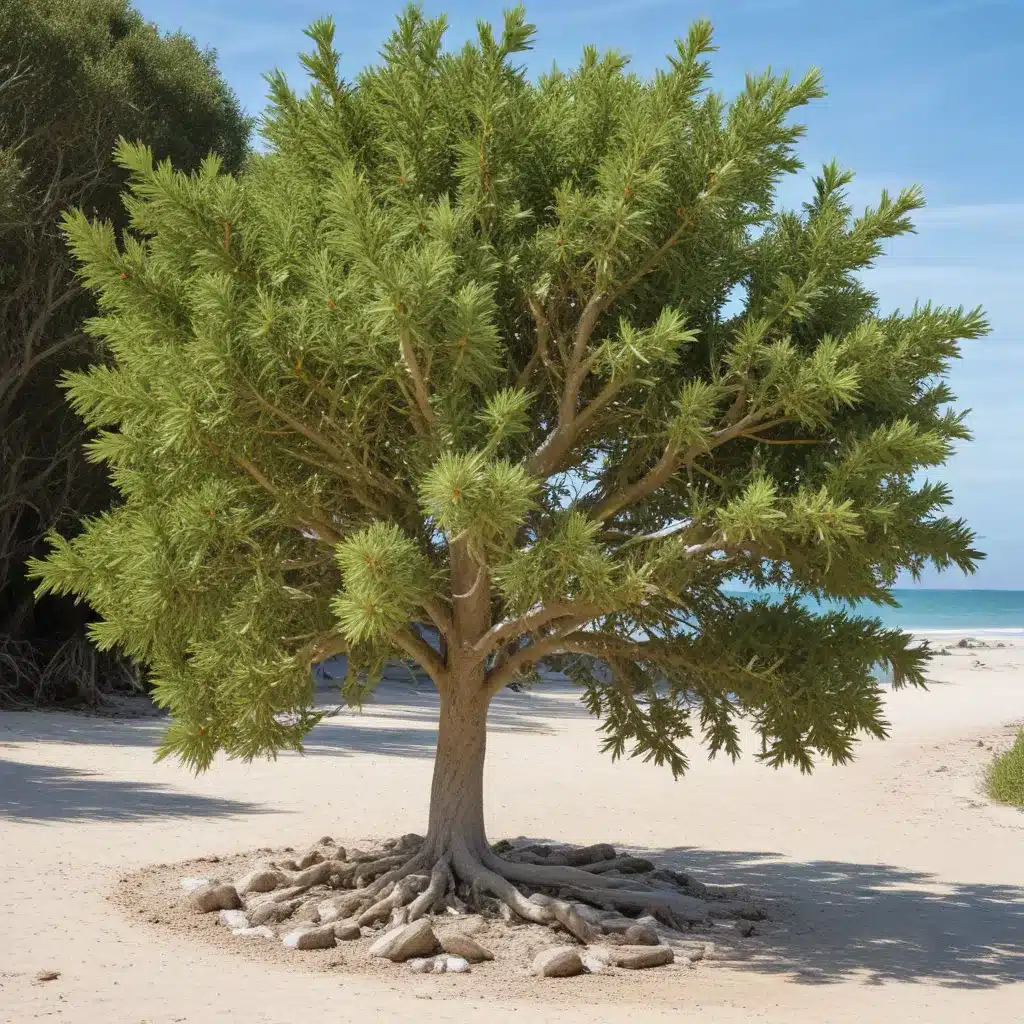
Coastal Castaways: Cultivating Salt-Tolerant Tree Species for Beachfront Gardens
Residing along the picturesque shores of South Florida, homeowners face a unique challenge when it comes to cultivating thriving trees and lush landscapes. The salty, often inhospitable coastal environment poses obstacles that inland gardeners need not consider. Yet with careful species selection and precise maintenance, the rewards of a beautiful, hurricane-resilient beachfront oasis are well within reach.
Palm Maintenance
Palm trees are a quintessential component of any tropical or subtropical landscape, but their specific care requirements must be addressed. Regular pruning and trimming of dead fronds and spent flower stalks is essential, both for aesthetic appeal and to mitigate storm damage potential. Employ a professional arborist for this delicate task, as improper pruning techniques can compromise the palm’s structural integrity.
In terms of watering regimes, coastal palms demand vigilance. While they exhibit some salt tolerance, excess salinity can still lead to stunted growth, nutrient deficiencies, and heightened susceptibility to pests and diseases. Supplement rainfall with deep, infrequent irrigation, allowing the soil to dry somewhat between waterings. Monitor soil salinity levels and adjust your approach as needed.
Tropical Storm Readiness
When it comes to weathering the region’s periodic hurricanes and tropical storms, wind resistance is a prime consideration. Select palm varieties known for their sturdy, flexible trunks, such as the Sabal Palm (Sabal palmetto) or Pindo Palm (Butia capitata). Avoid tall, top-heavy species that are more prone to uprooting or trunk failure.
Proper anchoring and staking of newly planted palms and trees is also crucial. Utilize a system of guy wires and ground stakes to firmly secure the root ball and prevent wind-induced movement. This helps the plant establish a robust, wind-resistant foundation. For mature specimens, consider installing root barrier systems to discourage excessive surface root growth that can compromise stability.
In the event of storm damage, swift damage mitigation is key. Prune away any snapped or dangling limbs, and apply wound dressing to prevent infection. Retain as much of the original canopy as possible, as sudden, severe pruning can shock the plant. With timely care and attention, many storm-battered trees can recover and thrive.
Local Soil Conditions
The salinity levels of coastal soils pose a significant challenge for tree health and establishment. Many species struggle to absorb adequate nutrients and water from highly saline substrates. Amend your soil with organic matter and gypsum to help counter the effects of accumulated salts. Regularly test your soil and adjust pH and mineral content as needed.
Proper drainage is also paramount. Waterlogged, poorly aerated soil can quickly lead to root rot and other debilitating issues. Incorporate sand or gravel into planting beds to improve percolation, and ensure that your irrigation system allows for sufficient runoff.
Pest and Fungal Issues
Coastal environments harbor a unique array of pests and diseases that can wreak havoc on vulnerable trees. Vigilant monitoring and early intervention are essential to maintaining tree health. Common culprits include palm weevils, scale insects, and various fungal pathogens that thrive in the moist, salty air.
Opt for organic control methods whenever possible, such as horticultural oils, insecticidal soaps, and biological agents. Avoid broad-spectrum pesticides that can disrupt the delicate ecological balance. Additionally, proper cultural practices, like pruning and site sanitation, can go a long way in discouraging pest infestations and disease outbreaks.
Fertilization Schedules
Coastal trees and palms have specialized nutrient requirements to thrive in the demanding beachfront environment. Implement a balanced, slow-release fertilizer regimen, applied at the appropriate timing and frequency. The ideal ratio of nitrogen, phosphorus, and potassium can vary by species, so consult with a local arborist or horticulturist to determine the optimal formula for your landscape.
Slow-release formulations are preferable, as they provide a steady, measured supply of essential macro- and micronutrients. This helps mitigate the risk of nutrient leaching or salt buildup that can occur with quick-release products. Adjust your feeding schedule to account for seasonal variations and storm events.
Planting Guidelines
When establishing new trees in a coastal setting, thoughtful site preparation is critical. Amend the planting hole with nutrient-rich organic matter and gypsum to counteract salinity. Ensure proper drainage by adding gravel or sand to the base of the hole.
Carefully consider plant spacing and placement. Allow sufficient room for the tree’s mature canopy and root zone, and position specimens to maximize wind protection from surrounding structures or other vegetation. An acclimation period of at least one year is recommended to help the plant adapt to its new environment before subjecting it to the full force of the coastal climate.
Recommended Species
When selecting trees for your beachfront garden, prioritize palm varieties that exhibit exceptional salt and wind tolerance. The Sabal Palm (Sabal palmetto), Pindo Palm (Butia capitata), and Cabbage Palm (Sabal palmetto) are all reliable choices.
For coastal hardwoods, the Live Oak (Quercus virginiana), Gumbo Limbo (Bursera simaruba), and Sea Grape (Coccoloba uvifera) thrive in the salty, exposed conditions. Complement these with hardy shrubs like Wax Myrtle (Morella cerifera) and Saw Palmetto (Serenoa repens) to create effective windbreaks and erosion control.
By heeding the unique requirements of the coastal environment and selecting the right salt-tolerant tree species, South Florida homeowners can transform their beachfront landscapes into lush, hurricane-ready oases. With diligent care and attention, these “coastal castaways” can flourish and provide decades of beauty, function, and resilience. For more information on cultivating a thriving coastal garden, visit South Florida Trees.


